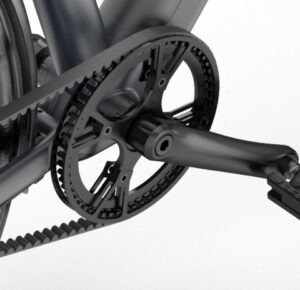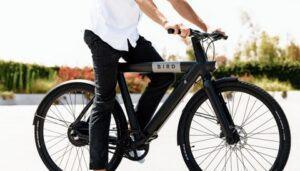A Flight of Your Own
The e-scooter business has never been a big money maker, and as the pandemic emptied most urban areas, shared scooter rentals tanked. But e-bike ownership, as a way to avoid the risk of public transportation, has taken off as a speedy and germ-free way to travel in cities.

Bird, founded in 2017, is well-known for its fleets of ever improving scooters in more than 300 cities worldwide. Now, it’s rolling out its first Bird Bike. Looking sturdy and serious in Stealth Black or Gravity Gray, it offers you a choice of a step-over A-frame or step-through V-frame configuration in commercial-grade aluminum alloy.
There’s no nonsense here, and much to celebrate. The 500-watt Bafang electric motor in the rear hub moves you along at 20 miles per hour with a range of up to 50 miles from the removable 36-volt battery. U.S. riders get half-kilowatt of power, while UK and EU riders have to make do with half that (that’s the law).
Other tech benefits include a no-stretch carbon cord technology in place of the familiar chain we all grew up with. It lasts longer and is likely cleaner and easier to maintain. As a 2021 electronic device, the Bird Bike offers a backlit LCD dash display on the handlebars and Bluetooth and app connectivity. You stop with mechanical disc brakes, and integrated LED lights show you the way.
Waiting for Some Seat Time
I haven’t had a chance to ride one of these babies yet, but I hope to. Last year, with my mask and distancing, I took a competitor for a test ride on the hills of San Francisco. With a thumb throttle, you can get help on the hills and a break on the flats while pedaling when you feel like it.

I remember buying a brand-new bike for $40 as a kid, and more recently, a high-quality, name-brand 21-speed regular bike cost me $500. But e-bikes, with their tech and “assistance,” are a bit dearer. The Bird Bike retails at $2,299. It’s cheaper than a car—or a motorcycle—and very inexpensive to run. You can order it online and Bird’ll ship it to you in a few weeks. There’s a 30-day guarantee, and you can get a full refund if you don’t like it. I don’t think Bird expects many takers on the return offer.
Netherlands residents have known the charm of biking for half a century. When a supporting infrastructure is in place, it’s a dream for a single person without a lot of baggage. Cities, especially flat ones, offer the friendliest environment, although safety remains an issue, as does security. The advantage of a shared scooter or bike diminishes when you have to park your ride or take it on public transit part of the way, but if it’s yours, you can be sure it’s there when you need it and set up the way you like it.
In Europe, bikes for commuting make sense, but in much of America, it’s a tougher sell. I can’t use one to pedal 29 miles to work. If we built massive bike parking garages at our commuter train stations (like the Dutch), bikes could serve as last-mile rides. But for many of us, two-wheeled devices are for recreation. To make them into commuter vehicles, we need to build out safe places to ride and integrate bikes with other transit systems to work toward the amazing system enjoyed elsewhere. Bikes are clean and efficient, and we need lots of that today.
Learn more or order your own at bird.bike.co.
Story by Steve Schaefer. Photos from Bird.

More E-Bike Info
News: VanMoof Expands E-Bikes
Feature: Going Dutch Cycling
Micromobility: Test Ride: VanMoof S3
